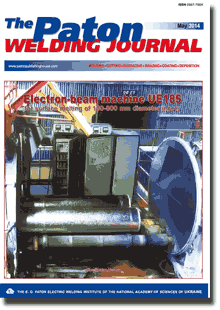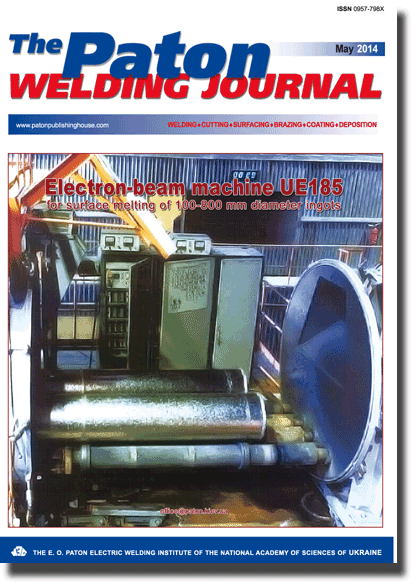| 2014 №05 (04) |
DOI of Article 10.15407/tpwj2014.05.05 |
2014 №05 (06) |

The Paton Welding Journal, 2014, #5, 28-32 pages
PECULIARITIES OF ALLOYING OF WELD METAL OF HIGH-STRENGTH ALUMINIUM ALLOY WELDED JOINTS WITH SCANDIUM
V.E. FEDORCHUK, O.S. KUSHNARYOVA, T.A. ALEKSEENKO and Yu.V. FALCHENKO
E.O. Paton Electric Welding Institute, NASU. 11 Bozhenko Str., 03680, Kiev, Ukraine. E-mail: office@paton.kiev.ua
Abstract
The problem of effect of solidification rate on structure of weld metal of scandium-containing aluminium alloys is considered. Peculiarities of scandium precipitation from melt in solidification of aluminium alloys under non-equilibrium conditions, simulating fusion welding, are investigated. Procedure of investigations has been developed and confirmed experimentally. Advantage of offered procedure over the existing ones consists in the fact that it allows simulate almost all the methods of fusion, from argon arc non-consumable electrode welding to electron beam welding. It is shown that the procedure satisfies the put aims completely. Microstructural investigations of ingots in height showed that within the interval of solidification rates from 103.3 to 102.5 °C/s the change of form of solidification occurs from dendritic to subdendritic ones. It was found that at rates of solidification, commensurable with solidification of weld metal, up to 0.41%Sc can be contained in solid solution of alloys. When applying the highly concentrated power sources, such as electron beam, it is possible to reach the similar value also in welds. In arc methods of welding approximately 0.3 % Sc can be assimilated in solid solution of weld metal. It was found that it is necessary to provide its content in weld metal at the level of 0.35-0.40wt.% to maximization of effect from alloying of welds with scandium. In this case the increase in mechanical properties of weld metal is provided both by refining of its crystalline structure, and also by hardening the solid solution by scandium. 7 Ref., 3 Tables, 4 Figures.
Keywords: high-strength aluminium alloys, scandium, alloying, weld metal, modifying of cast structure
Received: 27.02.14
Published: 28.05.14
References
1. Davydov, V.G., Rostova, T.D., Zakharov, V.V. et al. (2000) Scientific principles of making an alloying addition of scandium to aluminium alloys. Mat. Sci. and Eng. A, 280, 30-36. https://doi.org/10.1016/S0921-5093(99)00652-8
2. Rybin, V.V., Andreev, G.N., Barakhtina, N.N. et al. (2006) Some aspects in development of modern marine high-strength aluminium alloys with scandium. Voprosy Materialovedeniya, 1, 92-101.
3. Fridlyander, I.N., Danilov, S.F., Malysheva, E.N. (1992) Structure and properties of Al-Li alloys, alloyed with scandium. Proc. of 6th Int. Aluminium-Lithium Conf., 1, 381-386.
4. Rabkin, D.M., Lozovskaya, A.V., Sklabinskaya, I.E. (1992) Metals science of aluminium and its alloys. Kiev: Naukova Dumka.
5. (2001) Selected transactions of V.I. Dobatkin. Moscow: All-Russian Institute of Light Alloys.
6. Markashova, L.I., Grigorenko, G.M., Lozovskaya, A.V. et al. (2006) Effect of scandium additions on structure-phase state of weld metal in aluminium alloy joints after heat treatment. The Paton Welding J., 6, 7-11.
7. Ishchenko, A.Ya., Lozovskaya, A.V., Poklyatsky, A.G. et al. (1999) Structure and properties of joints made in welding of alloy AMg6 using filler wires with scandium. Avtomatich. Svarka, 4, 19-25.
Suggested Citation
V.E. FEDORCHUK, O.S. KUSHNARYOVA, T.A. ALEKSEENKO and Yu.V. FALCHENKO (2014) PECULIARITIES OF ALLOYING OF WELD METAL OF HIGH-STRENGTH ALUMINIUM ALLOY WELDED JOINTS WITH SCANDIUM. The Paton Welding J., 05, 28-32.The cost of subscription/purchase order journals or individual articles
| Journal/Currency | Annual Set | 1 issue printed |
1 issue |
one article |
| TPWJ/USD | 384 $ | 32 $ | 26 $ | 13 $ |
| TPWJ/EUR | 348 € | 29 € | 24 € | 12 € |
| TPWJ/UAH | 7200 UAH | 600 UAH | 600 UAH | 280 UAH |
| AS/UAH | 1800 UAH | 300 UAH | 300 UAH | 150 UAH |
| AS/USD | 192 $ | 32 $ | 26 $ | 13 $ |
| AS/EUR | 180 € | 30 € | 25 € | 12 € |
| SEM/UAH | 1200 UAH | 300 UAH | 300 UAH | 150 UAH |
| SEM/USD | 128 $ | 32 $ | 26 $ | 13 $ |
| SEM/EUR | 120 € | 30 € | 25 € | 12 € |
| TDNK/UAH | 1200 UAH | 300 UAH | 300 UAH | 150 UAH |
| TDNK/USD | 128 $ | 32 $ | 26 $ | 13 $ |
| TDNK/EUR | 120 € | 30 € | 25 € | 15 € |
AS = «Automatic Welding» - 6 issues per year;
TPWJ = «PATON WELDING JOURNAL» - 12 issues per year;
SEM = «Electrometallurgy Today» - 4 issues per year;
TDNK = «Technical Diagnostics and Non-Destructive Testing» - 4 issues per year.


